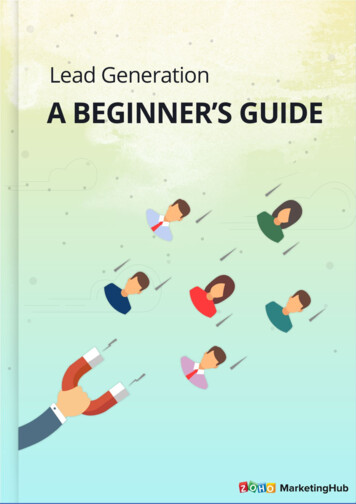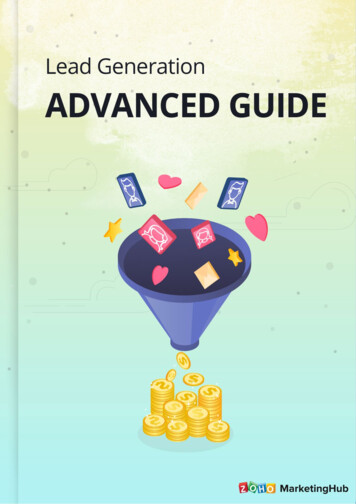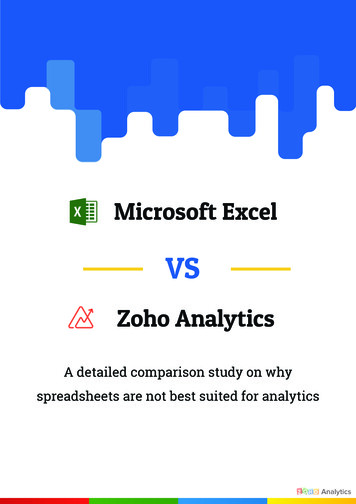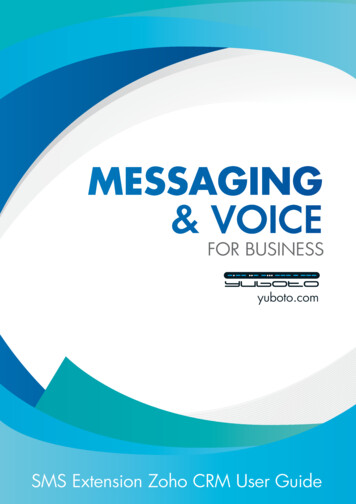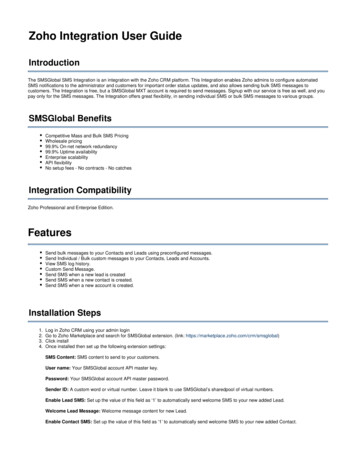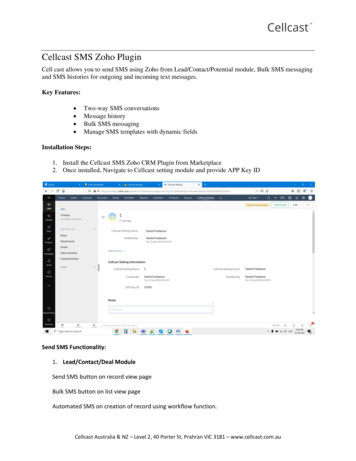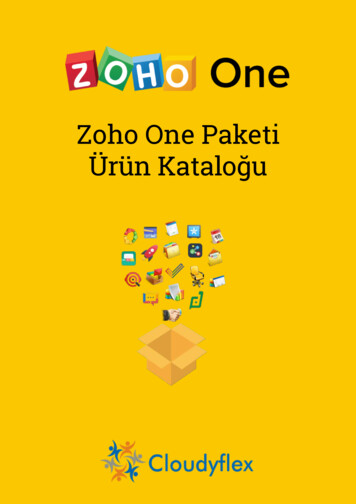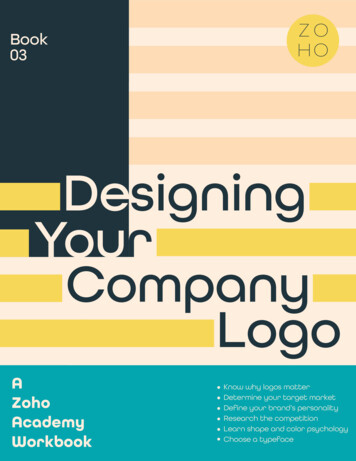
Transcription
Book03AZohoAcademyWorkbookZOHOKnow why logos matterDetermine your target marketDefine your brand’s personalityResearch the competitionLearn shape and color psychologyChoose a typeface
ZOHO01Logos: Why They MatterTarget. Apple. Nike. Starbucks. What comes to mind when you readeach of these company names? Our guess is that a red bullseye, anapple with a bite taken out of it, a swoosh, and a green mermaid areamong the first images evoked.Each of these brands is now so prominent that the moment we seetheir logos, we know whose “signature” we’re seeing, what theystand for, and how we feel about them. But they all started somewhere, with the hope that their logo would eventually prompt thatrecall.Your logo is your signature, yourcompany’s face, and often yourprospects’ first impression of yourbusiness. As one element of yourbrand identity, it’s the most important visual asset you’ve got.and a compelling logo is crucial inthis modern world of competingdistractions and saturated brandmessaging. (It’s been estimatedthat the average American is exposed to more than 5,000 brandsa day.) In order to be seen in allthat clutter, you’ve got to visuallydifferentiate yourself.Designing Your Company Logowww.zoho.com/academy2018 Zoho Academy
ZOHO02Of course, there’s a lot to consider when it comes to encapsulatingyour brand in a single emblem–one that captures your company’stone and essence, represents what you stand for, and conveys theunique value you bring to your industry (not to mention evokes adesired emotion in your prospects and customers). It requires astrategy that attends to the significance and pyschology of each discrete element, while perceiving their place in the single messageyou’ve boiled your business down to. That’s why we suggest you usea designer at some point in the process.Your logo will be with you for as long asyour business exists; and making thatinvestment in a professional early on maymake all the difference in your market’slong-term perception of you.But deciding to hire a designer doesn’t mean it isn’t important tounderstand the design process. The more familiar you are with thebasics of logo design, the better able you’ll be to make the right decisions–regardless of whether you’re at the helm of the project or not.So even if you’ve got a designer in mind, this workbook will prepareyou for that working relationship: by asking the questions any gooddesigner will ask, and helping you draft logos that are both creativeand appropriate to your brand. These drafts should give any designer a great starting point.Designing Your Company Logowww.zoho.com/academy2018 Zoho Academy
ZOHO03Clarify Your Target MarketWhy start with your target market? Because this is the group yourlogo will ultimately have to demonstrate empathy for and appeal to.It’s important to keep in mind from the beginning that the final decisions about your logo won’t ultimately be based on personal preference. They’ll be a matter of appropriateness and relevance to yourtarget market.Knowing your customer demographics and psychographics willhelp you answer some basic questions early on. For instance, if yourdemographic is pre-teens, you’ll probably want vibrant colors in aplayful logo. If your demographic is seniors, you’ll want especiallylegible typography in a logo whose elements conjure trust. If yourdemographic is middle-aged outdoor adventurers, you’ll want yourlogo to evoke ruggedness, strength, stamina, and the natural world.And so on.The point is to be clear about the people who will be intimately interacting with your brand. The more clarity you have on this, themore clarity you’ll have around what your design might include.as well as what it definitely should not include.Designing Your Company Logowww.zoho.com/academy2018 Zoho Academy
04Exercise: Describe YourTarget MarketZOHOThe type of person who most benefits from my product or servicestruggles withThis person isyears old, (male/female/nonbinary),for work,(married/single), does.and makes an annual salary ofTheir educational background isThe things about themselves they’re most proud of areFor my target market, “success” looks likeMy most loyal customers appreciate my business because we sharethese values:If I had to choose one message to send my target audience, it wouldbeDesigning Your Company Logowww.zoho.com/academy2018 Zoho Academy
ZOHO05Define Your Brand’s PersonalityNow it’s time to think about yourself. If you choose to work with adesigner, these are the kinds of questions they’ll ask; so you mightas well get them down on paper now:What set of circumstances caused us to start this business?What’s our origin story? What’s the story behind ourcompany’s name?What five things do we most value? What are our beliefs aboutthe world? About our industry? About people?How do we do what we do better than our competition? Whatmakes our product or service unique? What are the mostdistinctive features and benefits or our offering. andwhy do they matter to our customers?What are our goals and objectives? What drives us?If our company was a person, what would it be like to spendthe day with them? What adjectives would we use todescribe their personality?Think of this exercise as a process of self-discovery–as though youwere meeting your business for the first time.Designing Your Company Logowww.zoho.com/academy2018 Zoho Academy
06Exercise: Discover Languageand Images for Your BrandZOHOGather your employees, interview your team members, and have familymembers and friends work through these exercises with you. The morebrainstorming, the better!The words that immediately come to mind when I think about mybrand are:When I open Thesaurus.com and input those words into the search feature, the most compelling (and honest-to-my-brand) results are:When I open Google’s image search and input those words into thesearch feature, the most compelling (and honest-to-my-brand) imagesare:The strongest one-sentence mission statement I can create from thesewords is:The first images that come to mind when I re-read that mission statement are:Designing Your Company Logowww.zoho.com/academy2018 Zoho Academy
ZOHO07Research Your CompetitorsYou should be researching your competitors when it comes to everyaspect of your business. and your logo is no exception. What styleshave your competitors chosen? What colors do they employ? Whatvisual metaphors, symbols, or icons do they use? Is there an overarching set of patterns you notice? If there are commonalities, avoidthem in your own design. If your competitors’ logos are all modern,ask yourself why. and if you can discern no good reason, considera more traditional look for yours. You want to occupy a unique placein your specific market. and if your customers can’t tell your logoapart from anyone else’s, that may mean lost business for you.So strive for bothdifferent and better.While you’re doing this research, do pay attention to what logo elements you’re drawn to. See if you can articulate what you like anddon’t like about each logo you see. Shape? Harmony? Typography?If your competitors’ customers have made comments about theirlogos, take note of these. Knowing what’s working (or failing) fromthe customers’ point of view will be invaluable.Designing Your Company Logowww.zoho.com/academy2018 Zoho Academy
08Exercise: Scope out YourCompetitorsZOHOMy biggest competitor isTheir logo looks likeWhat I’m drawn to in their logo isWhat I don’t like about their logo isMy second biggest competitor isTheir logo looks likeWhat I’m drawn to in their logo isWhat I don’t like about their logo isMy third biggest competitor isTheir logo looks likeWhat I’m drawn to in their logo isWhat I don’t like about their logo isDesigning Your Company Logowww.zoho.com/academy2018 Zoho Academy
ZOHO09Choose Your Logo TypeAs you’re designing your logo, try experimenting with these types:1. Logotypes (wordmarks). With logotypes, the name of the business is thelogo. Think Google, FedEx, Coca-Cola, and Yahoo!2. Monogram logos (lettermarks). These are built around the company’sinitials. Think IBM, CNN, Uber, or H&M.3. Combination marks. Combination marks combine an image with text.They’re popular options because they’re more likely to be unique, and theyoffer flexibility across platforms. Think Burger King, AT&T, Taco Bell, andAdidas.4. Symbols or icons. These logos dispense with words altogether and insteaduse an image that represents the word. Think Apple, Shell, Twitter, and Target.5. Abstract logos. Abstract logos don’t have any inherent meaning in and ofthemselves; they’re forms that take on meaning as the brand becomesestablished. Think Audi, Nike, Pepsi, and BP.6. Emblems. An emblem is a kind of combination mark, but it’s presentedas a seal or crest. Think Starbucks and Harley Davidson. These logo types tendto be more visually complex.7. Mascots. Think KFC, Tony the Tiger, and the logos of many professionalsports teams.If your business isn’t a household name and your goal is to buildname recognition, include your company’s name in your logo,regardless of which type you choose.Designing Your Company Logowww.zoho.com/academy2018 Zoho Academy
ZOHO10Start SketchingWe know: We’ve recommended you use a designer; but taking sometime to do this on your own may confirm some ideas about whatyou want. Here are some suggestions:1. Use a pencil and paper. Sketching by hand is the quickest way to getideas out of your head to gauge how they look in two dimensions. It alsohas an important psychological dimension: You’ll know it’s not the“final” piece, so you’ll allow yourself to be messy, more creative, andwilling to humor your wilder ideas. Our perfectionist tendencies kick inon screen; we go into small-detail mode and forget the big picture.2. Stick with black-and-white. Leaving color out in the initial phaseswill ensure your attention is trained on the essential aspects of the logo(shape, font, positive and negative space), rather than on somethingthat’s easy to change. You’ll end up using black-and-white versions ofyour logo, anyhow (in print advertisements, for example), so you mightas well see how it looks now. A logo that looks good in black and whitewill also look good in color; but the same can’t always be said in reverse.3. Don’t erase or discard anything. Allow every concept you experiment with to evolve on its own; follow through on every sketch if youcan. Details you don’t initially like may spark new ideas for the nextiteration. What’s more, when you make yourself draw a bad idea, youclear your mind of clutter. And at the end of this process, don’t discardthe logos you don’t like! They may offer you (or your designer) something of value later on.Designing Your Company Logowww.zoho.com/academy2018 Zoho Academy
ZOHO11Exercise: Initial SketchingDesigning Your Company Logowww.zoho.com/academy2018 Zoho Academy
ZOHO12Get InspiredIf you’re feeling stuck during the sketching phase, forcing yourselfto sit there and stare at that blank piece of paper may not be yourmost valuable strategy. Get on Pinterest and see what you findthere. Start a collection of images that inspire you. Go to your localmuseum or art gallery. Look at books on pop culture, graphicdesign, or art history. Return to your favorite novel and pay attention to literary imagery. or simply take a walk downtown and takein the details of the logos you see on the storefronts there. Some ofyour best ideas might come from bringing two disparate images orexperiences together from these “imaginative journeys.”Designing Your Company Logowww.zoho.com/academy2018 Zoho Academy
13Consider Shape and ColorPsychologyZOHOOur brains are hardwired to process shapes and colors before words; sothese are elements worth paying attention to. There’s plenty of researchout there about shape and color psychology, and your designer shouldbe versed in it. Here’s a quick list of basic shapes and colors and whatthey subconsciously communicate:Circles and ovals: balance, security, trust, unity, integrity, harmony. Interlocking circlesrepresent community (think of the Olympics’ logo).Squares and rectangles: capability, honesty, rationality, professionalism. Shapes withstraight lines tend to symbolize structure and order, and are often described as “masculine.”Triangles: strength, stability, power, purpose directionRed: passion, energy, excitement, boldness, confidence, dangerYellow: optimism, friendliness, happiness, freshnessBlue: trust, reliability, loyalty, authority, confidence, tranquilityGreen: growth, life, natureREMEMBER:Purple: royalty, luxury, wealth, wisdom, spiritualityGray: maturity, timelessness, practicality, traditionBrown: stability, ruggedness, history (think vintage)Black: power, credibility, intellect, modernityWhite: simplicity, clarity, neutrality, purityDesigning Your Company Logowww.zoho.com/academyThe more colors in yourlogo, the costlier printing will be. And be sureto test your logo onbackgrounds of different colors: It won’talways be printed on thesame color canvas youdesigned it on.2018 Zoho Academy
ZOHO14Consider TypographyTake a look again at how you described your brand on page 6.Whether you wrote “quirky”, “cool”, “sophisticated”, “bold”, or anyother adjective, there’s a font out there (or one ready to be made) foryou:Serif fonts convey luxury, dignity, tradition, reliability, seriousness, stylishness, andelegance (think Gap).Sans serif fonts are more modern and clean-looking (think eBay), though they are versatile in what they can communicate. Sans serif fonts are more legible in small sizes.Script fonts give the impression of being handwritten (think Coca-Cola). They canconvey everything from elegance, to creativity, to personality, to intimacy.Decorative fonts are highly stylized and eye-catching (think Disney). They can communicate just about anything. but above all, they communicate uniqueness andsingularity.ScriptAbove all, prioritize legibility andappropriateness to your b
target market. Knowing your customer demographics and psychographics will help you answer some basic questions early on. For instance, if your demographic is pre-teens, you’ll probably want vibrant colors in a playful logo. If your demographic is seniors, you’ll want especially legible typography in a logo whose elements conjure trust. If your demographic is middle-aged outdoor adventurers .

